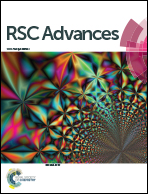Bandgaps of noble and transition metal/ZIF-8 electro/catalysts: a computational study†
Abstract
Zeolitic imidazolate frameworks (ZIFs) are designed with metals as center atoms, connected by imidazole-like linkers. The created structures have been employed considerably in the field of advanced energy materials, including catalysis/electrocatalysis and energy storage and harvesting applications. In the present study, the bandgaps of pristine and doped ZIF-8 (using noble and transition metal dopants such as Pd, Pt, Ni, Mn, Co, Cu, Fe, and Ti) are determined. This can result in a promising approach to enhance the corresponding electronic properties while applying noble metal-free dopants. To determine the bandgap values, a quantum mechanical modeling based on density functional theory (DFT) was applied. Then, due to the time-consuming and complicated nature of this approach, the obtained results from the DFT study were then employed to develop the support vector machine (SVM) model to estimate the bandgap of the resulting nanostructure. The outcomes of the proposed model showed its high accuracy, with R2 of 0.98 and root mean squared error (RMSE) of 0.04. The developed model could have great value in designing various ZIF-8-based nanostructures, particularly when applied in electro/catalytic reactions, e.g., electrocatalytic hydrogen evolution reaction or catalytic hydrogenation reaction, through a simple approach.



 Please wait while we load your content...
Please wait while we load your content...